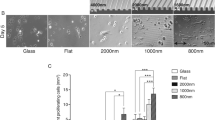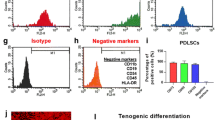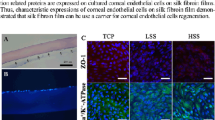Abstract
The effect of recombinant spidroin (RS) hydrogel (HG) on anterior epithelial cells and keratocytes of the human cornea was studied in vitro. Corneal injuries are highly prevalent in developing countries according to the World Health Organization. Various technologies have recently been proposed to restore the damaged surface of the cornea. Use of biodegradable silk-based materials, including recombinant analogs of the spider silk protein spidroin, is an important avenue of research in the field of wound healing and corneal regeneration. Spidroins are well known for their optimal balance of strength and elasticity. Given their biological compatibility, lack of immunogenicity, and biodegradability, spidroins provide a biomaterial for tissue engineering and regenerative medicine. HGs based on RS rS2/12-RGDS were therefore tested for cytotoxicity toward isolated corneal epithelial cells and keratocytes with regard to possible changes in cell phenotype and migratory activity. A promising outlook and therapeutic potential were demonstrated for RS-based HGs.

Similar content being viewed by others
REFERENCES
Whitcher, J.P., Srinivasan, M., and Upadhyay, M.P., Corneal blindness: a global perspective, Bull. World Health Organ., 2001, vol. 79, no. 3, pp. 214–221.
Gain, P., Jullienne, R., He, Z., et al., Global survey of corneal transplantation and eye banking, JAMA Ophthalmol., 2016, vol. 134, no. 2, pp. 167–173.
Jeng, B.H. and Ahmad, S., In pursuit of the elimination of corneal blindness: Is establishing eye banks and training surgeons enough?, Ophthalmology, 2021, vol. 128, no. 6, pp. 813–815.
Mahdavi, S.S., Abdekhodaie, M.J., Mashayekhan, S., et al., Bioengineering approaches for corneal regenerative medicine, Tissue Eng. Regener. Med., 2020, vol. 17, no. 5, pp. 567–593.
El-Sherbiny, I.M. and Yacoub, M.H., Hydrogel scaffolds for tissue engineering: Progress and challenges, Global Cardiol. Sci. Pract., 2013, vol. 2013, no. 3, pp. 316–342.
Jameson, J.F., Pacheco, M.O., Nguyen, H.H., et al., Recent advances in natural materials for corneal tissue engineering, Bioengineering (Basel), 2021, vol. 8, no. 11, p. 161.
Han, Y., Li, C., Cai, Q., et al., Studies on bacterial cellulose/poly(vinyl alcohol) hydrogel composites as tissue-engineered corneal stroma, Biomed. Mater., 2020, vol. 15, no. 3, p. 035022.
Kong, B., Chen, Y., Liu, R., et al., Fiber reinforced GelMA hydrogel to induce the regeneration of corneal stroma, Nat. Commun., 2020, vol. 11, no. 1, p. 1435.
Bowen, C.H., Dai, B., Sargent, C.J., et al., Recombinant Spidroins fully replicate primary mechanical properties of natural spider silk, Biomacromolecules, 2018, vol. 19, no. 9, pp. 3853–3860.
Zhang, Q., Li, M., Hu, W., et al., Spidroin-based biomaterials in tissue engineering: general approaches and potential stem cell therapies, Stem Cells Int., 2021, vol. 2021, p. 7141550.
Ramezaniaghdam, M., Nahdi, N.D., and Reski, R., Recombinant spider silk: promises and bottlenecks, Front Bioeng. Biotechnol., 2022, vol. 10, p. 835637.
Teplenin, A., Krasheninnikova, A., Agladze, N., et al., Functional analysis of the engineered cardiac tissue grown on recombinant spidroin fiber meshes, PLoS One, 2015, vol. 10, no. 3, p. e0121155,
Agapov, I.I., Pustovalova, O.L., Moisenovich, M.M., et al., Three-dimensional scaffold made from recombinant spider silk protein for tissue engineering, Dokl. Biochem. Biophys., 2009, vol. 426, no. 1, pp. 127–130. https://doi.org/10.1134/s1607672909030016
Agapova, O.I., Efimov, A.E., Moisenovich, M.M., et al., Comparative analysis of three dimensional nanostructure of porous biocompatible scaffolds made of recombinant spidroin and silk fibroin for regenerative medicine, Russ. J. Transplantol. Artif. Org., 2015, vol. 17, no. 2, pp. 37–44. https://doi.org/10.15825/1995-1191-2015-2-37-44
Jansson, R., Thatikonda, N., Lindberg, D., et al., Recombinant spider silk genetically functionalized with affinity domains, Biomacromolecules, 2014, vol. 15, no. 5, pp. 1696–1706.
Bogush, V.G., Sokolova, O.S., Davydova, L.I., et al., A novel model system for design of biomaterials, based on recombinant analogs of spider silk protein, J. Neuroimmune Pharmacol., 2009, vol. 4, no. 1, pp. 17–27.
Hirano, Y., Okuno, M., Hayashi, T., et al., Cell-attachment activities of surface immobilized oligopeptides RGD, RGDS, RGDV, RGDT, and YIGSR toward five cell lines, J. Biomater. Sci., Polym. Ed., 1993, vol. 4, pp. 235–243.
Kumar, V.B., Tiwari, O.S., Finkelstein-Zuta, G., et al., Design of functional RGD peptide-based biomaterials for tissue engineering, Pharmaceutics, 2023, vol. 15, p. 345.
Revkova, V., Sidoruk, K., Kalsin, V., et al., Spidroin silk fibers with bioactive motifs of extracellular proteins for neural tissue engineering, ACS Omega, 2021, vol. 6, pp. 15264–15273.
Nosenko, M.A., Moysenovich, A.M., Zvartsev, R.V., et al., Novel biodegradable polymeric microparticles facilitate scarless wound healing by promoting re-epithelialization and inhibiting fibrosis, Front. Immunol., 2018, vol. 9, p. 2851.
Funding
Producer strain culturing, RS isolation and purification, and HG preparation and sterilization were carried out within the state assignment of NRC “Kurchatov Institute.”
Author information
Authors and Affiliations
Corresponding author
Ethics declarations
ETHICS APPROVAL AND CONSENT TO PARTICIPATE
All studies were conducted in accordance with the principles of biomedical ethics as outlined in the 1964 Declaration of Helsinki and Its later amendments. Donor material (cadaver cornea and their derivative isolated stromal cells) were used as biomaterial for experimental research. The studies were carried out in vitro in accordance with authorized procedures and a special legal approval from the Novosibirsk Oblast Division of the Federal Service for Surveillance in Healthcare (license no. L041-00110-47/00574034 dated April 7, 2020, which allows the use of tissues isolated from cadaver human eyes for transplantation and scientific research purposes).
CONFLICT OF INTEREST
The authors of this work declare that they have no conflicts of interest.
Additional information
Translated by T. Tkacheva
Publisher’s Note.
Pleiades Publishing remains neutral with regard to jurisdictional claims in published maps and institutional affiliations.
Rights and permissions
About this article
Cite this article
Agapova, O.I., Ostrovsky, D.S., Khubetsova, M.K. et al. Hydrogels Based on Recombinant Spidroin Stimulate Proliferation and Migration of Human Corneal Cells. Dokl Biol Sci 513 (Suppl 1), S41–S44 (2023). https://doi.org/10.1134/S0012496623600173
Received:
Revised:
Accepted:
Published:
Issue Date:
DOI: https://doi.org/10.1134/S0012496623600173




